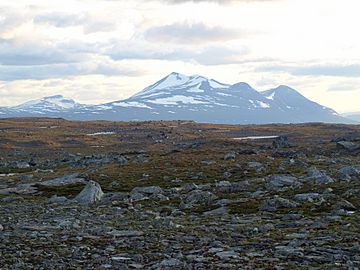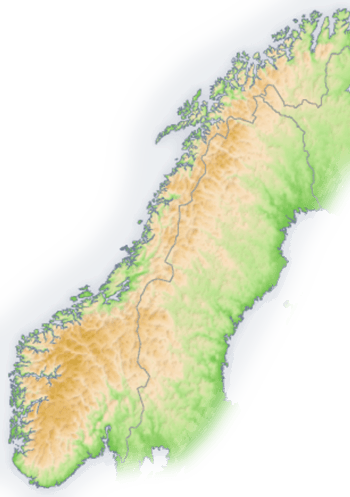Scandinavian Mountains facts for kids
Quick facts for kids Scandinavian Mountains |
|
|---|---|

Mount Áhkká in Stora Sjöfallet National Park, Northern Sweden
|
|
| Highest point | |
| Peak | Galdhøpiggen (Lom) |
| Elevation | 2,469 m (8,100 ft) |
| Dimensions | |
| Length | 1,700 km (1,100 mi) |
| Width | 320 km (200 mi) |
| Naming | |
| Native name | Error {{native name}}: an IETF language tag as parameter {{{1}}} is required (help) |
| Geography | |
| Countries | Norway, Sweden and Finland |
| Range coordinates | 65°N 14°E / 65°N 14°E |
The Scandinavian Mountains are a mountain range that runs through the Scandinavian Peninsula. The western sides of the mountains drop steeply into the North Sea and Norwegian Sea, where they form the fjords of Norway. To the north they form the border between Norway and Sweden, and passing across the Arctic Circle. A small part of the range runs into Finland, but this part mostly consists of hills.
Galdhøpiggen in southern Norway is the highest peak in the range, at 2,469 metres (8,100 ft). Kebnekaise has the highest peak on the Swedish side, at 2,104 m (6,903 ft). Halti is the highest peak in Finland, at 1,324 m (4,344 ft). The range's proximity to the Arctic and the North Atlantic ocean has caused the formation of many icefields and glaciers.
Images for kids
-
Simplified geological map of Fennoscandia. The Caledonian nappes are shown in green. Note the windows of bedrock belonging to the Transscandinavian Igneous Belt in blue. The Svecofennian and Sveconorwegian provinces are shown in yellow and salmon respectively.
-
Falketind in Jotunheimen
See also
 In Spanish: Alpes escandinavos para niños
In Spanish: Alpes escandinavos para niños










